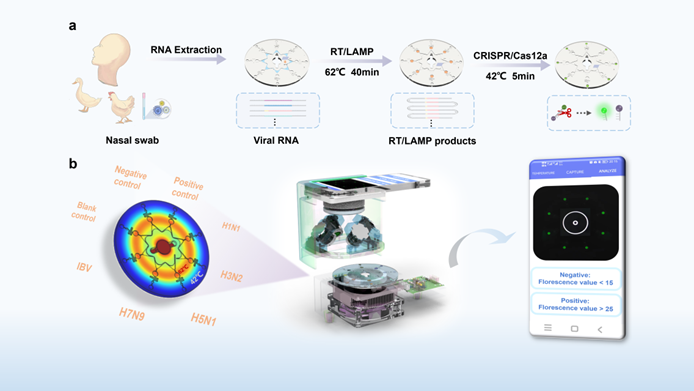
Recently,a research group led by Prof. LIU Yong and Prof. ZHU Ling from the Hefei Institutes of Physical Science of the Chinese Academy of Sciences, developed a spatial encoding of centrifugal microfluidic disc integrated smartphone-controlled (SEDphone) platform for influenza virus subtypes detection.
The research results were published in Sensors and Actuators: B. Chemical.
Influenza virus poses a serious public health threat, causing epidemics annually with high morbidity and mortality rates. Moreover, influenza viruses exhibit high mutation rates and manifest in multiple subtypes, necessitating different clinical intervention strategies. Therefore, there is an urgent need for an accurate, rapid, and portable solution to differentiate between different influenza virus subtypes, control virus spread, and guide clinical treatment decisions.
In this study, researchers developed a new method combining two advanced technologies, Loop-mediated Isothermal Amplification (LAMP) and CRISPR/Cas12a, to quickly and accurately detect different types of influenza viruses. This technique amplifies target sequences via LAMP and detect them through CRISPR/Cas12a-mediated trans-cleavage activity, thereby cleaving reporter probes and releasing fluorescent signals. This method is highly sensitive and minimizes false positives. To facilitate the application of different targets, researchers have developed a versatile model that can target various flu strains. After optimization, this method can identify five types of influenza (H1N1, H3N2, H5N1, H7N9, and Influenza B) within 45 minutes, even at very low virus concentrations (10 copies/μL).
In addition, to achieve integrated operation of LAMP amplification and CRISPR detection, researchers fabricated a centrifugal microfluidic chip with spatial encoding functionality. They also developed a portable testing device called SEDphone, which is controlled by a smartphone. This device can amplify and detect multiple types of influenza viruses at the same time. By using a dual temperature zone design, they resolved the temperature differences needed for the two technologies. Tests with clinical samples showed that this method and the SEDphone device are effective for quickly identifying different flu subtypes.
"Our research offers a new way to quickly and accurately detect various pathogens in real-time. This method can be used in fever clinics or at home, helping to reduce the risk of unnecessary cross-infection and easing the burden on healthcare systems," said Dr. ZHU Cancan, a member of the team.

Schematic illustration of the SEDphone system workflow (Image by ZHU Cancan)